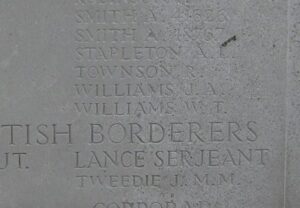Glynarthen is a small village situated south of the A487 coastal road, about a mile from both Sarnau and Tanygroes. Glynarthen Schoolhouse is situated in the heart of the village of Glynarthen, which is itself part of the community of Penbryn. The schoolhouse is presently for sale, for conversion into a dwelling, and as a result, the war memorial tablet, which commemorates the nine former pupils who fell during the Great War, has been removed to Sarnau Memorial Hall, where it is now on display. The photograph of the memorial has been kindly supplied by Raymond Jones.
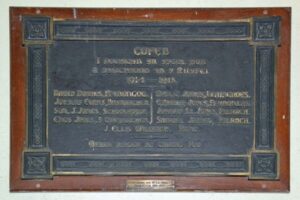
The Great War, 1914-1918
David John Davies, Second Lieutenant, Royal Welsh Fusiliers. David was the son of Owen and Frances Davies, of Ffynongog, Beulah. He had graduated from Aberystwyth University before taking up a teaching post at York, but in 1914 returned to Wales to study in agriculture back at Aberystwyth. He was commissioned into the Royal Welsh Fusiliers in 1915, and posted to the 10th Battalion, RWF which was in France attached to 76 Brigade, 3rd Division. The division moved to the Somme sector in July 1916, in preparation for its part in the assault on Montauban Alley and Pozieres. It saw heavy fighting over the coming weeks, playing a prominent part in the assault on Delville Wood, where the 10th RWF was awarded two Victoria Crosses. The division moved to the Serre sector early in November, and on 13 November the 10th RWF took part in an attack on the Serre trenches, near Mark and Matthew Copse. David was among a number of officers killed during the attack of 13 November 1916. He was 37 years old, and is commemorated on the Thiepval Memorial, France.
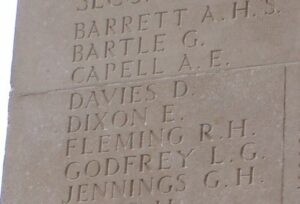
John Evans, Gunner, 112115, Royal Garrison Artillery. John was the son of Benjamin and Jane Evans, of Mount Farm, Llanarth. He had worked as a shopkeeper in the valleys before returning to Llanarth prior to 1911 due to ill health, and then looks to have lived at Brynarthen, Sarnau, where he worked as a farmer and egg merchant. He enlisted at Brecon into the army, and was posted to the 37th Company, Royal Garrison Artillery. John had been stationed at Portsmouth when he began to feel ill, suffering from severe headaches. John received some hospital treatment, but returned to west Wales for further treatment at Pembroke Dock Military Hospital. He was on his way back to Portsmouth, when he was found hanging at Carmarthen on 24 November 1916, after having apparently committed suicide. John was 36 years old, and is buried in Brynrhiwgaled Independent Chapelyard.
Samuel James, Private, 2635, Welsh Guards. Samuel was the son of Evan and Hannah James, of Brynpark, Bryngwyn, Newcastle Emlyn. He served in the 2nd Battalion, Welsh Guards, which was a Reserve Battalion. Samuel became ill whilst still training to go to France, and died in Caterham Military Hospital, Surrey on 2 April 1916 of pneumonia. Samuel was just 20 years old, and is buried at Glynarthen Congregational Chapelyard.
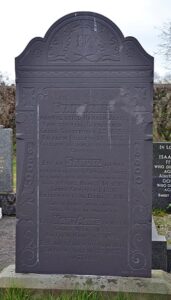
Daniel Thomas Jones, Second Lieutenant, Royal Welsh Fusiliers. Daniel was born on 21 January 1895, the son of David Glyn Jones, and Martha Jones, of Glynarthen. He was commissioned into the Royal Welsh Fusiliers, and was posted to France where he became attached to the 1st Battalion, Royal Welsh Fusiliers. The battalion had been in France since 7 October 1914, attached to 22 Brigade, 7th Division, and had fought during the First Battle of Ypres. In March 1915 the Division fought at the Battle of Neuve Chapelle, and during May at the Battle of Aubers Ridge, and at Festubert, before taking part in the Battle of Loos in September. In the summer of 1916, the Division was on the Somme, and took part in the Battle of Albert, where they captured Mametz, one of the few successes of 1 July 1916. They then fought at the Battle of Bazentin, and the Attacks on High Wood. The Division then took part in the Battle of Delville Wood, and the Battle of Guillemont, before spending the winter on the Ancre. In March 1917 they followed up the German Retreat to the Hindenburg Line, and took part in Flanking Operations Round Bullecourt, alongside the Australians. Daniel was killed in action at Bullecourt on 4 May 1917, aged 23. Daniel is commemorated on the Arras Memorial, France.
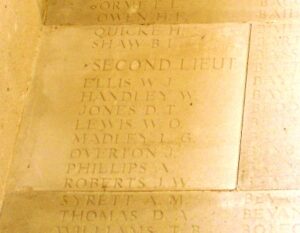
Evan Jones, Saddler, 5253, Royal Field Artillery. Evan was the son of Mary Jones, of Vron Villa, Sarnau. He enlisted at Caerphilly into the Royal Artillery, and was posted to France with the 20th Brigade, Royal Field Artillery, which was attached to the 5th Division. Evan must have been invalided home early in 1918, and he died on 29 August 1918. Evan is buried at Penbryn (St. Michael) Churchyard.
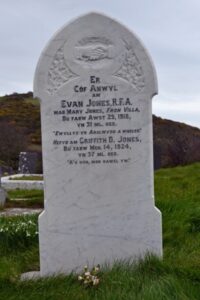
Evan Philip Jones, Second Mate, Mercantile Marine. Evan was the son of Ben and Anne Jones, of Brigydon, Tresaith. He served with the Mercantile Marine aboard the cargo steamer S.S. Greenhill. On 15 December 1917 Greenhill was en route from Blyth to Dunkirk with a cargo of coal when she became wrecked on Long Sand in the Thames Estuary. At least five men were drowned in the sinking, including Evan. He was 26 years old when he died that day and is not recognised as a war casualty by the CWGC because Greenhill was not a war loss.
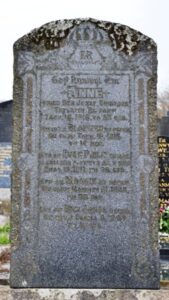
John Lloyd Jones, Private, 2637, Welsh Guards. John was the son of Thomas and Elizabeth Jones, of Pilbach Isaf, Glynarthen. He enlisted into the Welsh Guards, and was training when he was taken ill, suffering from pneumonia. He died in hospital on 6 April 1916, aged 27, and was brought home for burial in Glynarthen Congregational Chapelyard.
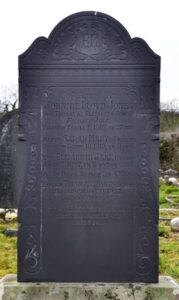
Simon James Jones, Lieutenant, South Lancashire Regiment. Simon was the son of David Orllwyn and Elizabeth Jones, of Marffo, Glynarthen, Henllan. His father was the schoolmaster at Glynarthen. Simon was commissioned into the South Lancashire Regiment, and was posted to France, joining the 2nd Battalion, South Lancashire Regiment. The battalion had been in France since the outbreak of war, attached to 7 Brigade, and on 26 October 1915 was transferred to 64 Brigade, 21st Division. The Division had fought throughout the Somme Offensive in 1916, and in March 1917 followed the German Retreat to the Hindenburg Line. In April the Division fought at Arras and Bullecourt, and later that year fought at the Third Battle of Ypres, and the Battle of Cambrai. The division was one of the units hit by the German Spring Offensive on the Somme in March 1918, fighting at the Battle of St Quentin and the First Battle of Bapaume, before being evacuated to Flanders to rest. Unluckily though, the Germans launched a fresh offensive on the Lys in April 1918, and the division was caught up in the thick of the fighting again, during the Battle of Messines, and the Second Battle of Kemmel. The battered division now moved south to rebuild, but again was unlucky, as the Germans launched a fresh offensive on the Chemin-des-Dames, and the division was caught up in the action again, fighting in the Battle of the Aisne. Simon was badly wounded here, and died on 5 June 1918, aged 24. He is buried at Marfaux British Cemetery, France.
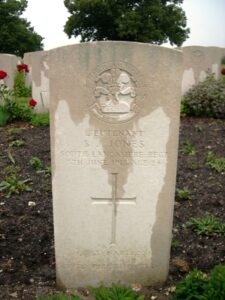
John Ellis Williams, Private, 57912, Royal Welsh Fusiliers. John was the son of John and Jane Williams, of Pant, Sarnau, and the husband of Mary Williams, of Merthyr. He enlisted at Merthyr into the Welsh Regiment, and was posted to France, probably in 1917, joining the 9th Battalion, Royal Welsh Fusiliers, which was attached to 58 Brigade, 19th (Western) Division. In 1917 the Division moved North to Ypres, taking part in the Battle of Messines, and fought on the Menin Road and at Polygon Wood, before moving up to Broodseinde, Poelcappelle and Passchendaele Village itself. In 1918 they were caught up in the German Spring Offensive near St. Quentin, where they suffered terrible casualties, and fought at the Battle of Bapaume. They moved to Ypres, but were caught up in the German attack at Messines. After suffering terribly again, they moved South to the quieter French sector to rebuild, but were caught up in the German offensive on the Aisne. John was killed in action here on 14 June 1918. He was 36 years old, and is commemorated on the Soissons Memorial, France.
